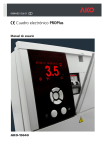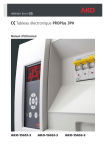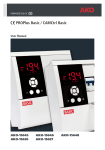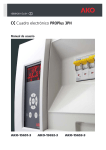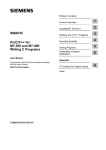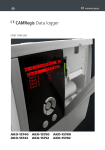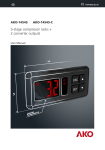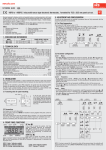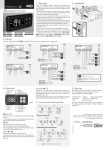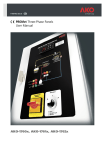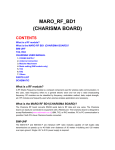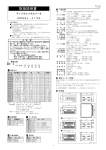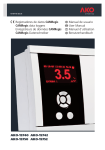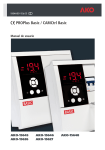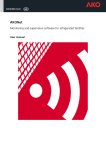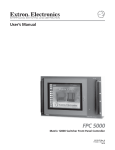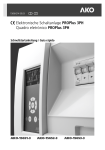Download PROPlus 3PH Electronic Panel
Transcript
1565H202 Ed.01 GB PROPlus 3PH Electronic Panel User Manual AKO-15651-3 AKO-15652-3 AKO-15653-3 Index Page 1.- Presentation ..............................................................................................................................3 1.1.- Maintenance...................................................................................................................3 1.2.- Cautions..........................................................................................................................3 2.- Versions and references...............................................................................................................3 3.- Installation.................................................................................................................................4 4.- Component location ...................................................................................................................6 5.- Recommendations .....................................................................................................................7 6.- Description ................................................................................................................................8 6.1.- Quick access to functions ..................................................................................................8 6.2.- Status LEDs......................................................................................................................9 6.3.- Messages ........................................................................................................................9 7.- Wiring .....................................................................................................................................10 7.1.- Pressure controller wiring options ..................................................................................11 8.- Programming menu .................................................................................................................12 8.1.- Basic initial configuration................................................................................................12 9.- Operation ................................................................................................................................15 9.1.- Compressor control ......................................................................................................15 9.2.- Defrost control ..............................................................................................................17 9.3.- Fan control....................................................................................................................19 9.4.- Light control ..................................................................................................................19 9.5.- Pump down function ......................................................................................................20 9.6.- Alarms...........................................................................................................................21 9.7.- Data logging..................................................................................................................22 9.8.- HACCP logging ..............................................................................................................23 10. Advanced configurations ..........................................................................................................24 10.1.- Digital inputs...............................................................................................................24 10.2.- Auxiliary relay ..............................................................................................................25 10.3.- Access code (password) ................................................................................................26 10.5.- Return to initial parameters...........................................................................................26 10.6.- Program version...........................................................................................................26 11.- Connectivity...........................................................................................................................27 12.- Wiring diagrams .....................................................................................................................28 13.- Parameters.............................................................................................................................32 14.- Technical specifications...........................................................................................................37 AKO Electromecànica thanks you and congratulates you on the purchase of our product, the development and manufacture of which involved the most innovative technologies, as well as rigorous production and quality control processes. Our commitment to achieving customer satisfaction and our continuous efforts to improve day by day are confirmed by the various quality certificates obtained. This is a high performance, technologically advanced product. Its operation and the final performance achieved will depend, to a great extent, on correct planning, installation, configuration and commissioning. Please read this manual carefully before proceeding to install it and respect the instructions in the manual at all times. Only qualified personnel may install the product or carry out technical support. This product has been developed for use in the applications described in the manual. AKO Electromecànica does not guarantee its operation in any use not foreseen in this document and accepts no liability in the case of damage of any type which may result from incorrect use, configuration, installation or commissioning. Complying with and enforcing the regulations applying to installations where our products are destined to be used is the responsibility of the installer and the customer. AKO Electromecànica accepts no liability for damage which may occur due to failure to comply with these regulations. Rigorously follow the instructions described in this manual. In order to extend the lifetime of our products to the maximum, the following points must be observed: Do not expose electronic equipment to dust, dirt, water, rain, moisture, high temperatures, chemical agents or corrosive substances of any type. Do not subject equipment to knocks or vibrations or attempt to handle them in any way differently to that indicated in the manual. Do not under any circumstances exceed the specifications and limitations indicated in the manual. Respect the indicated environmental conditions for operation and storage at all times. During installation and on completion of this, avoid the presence of loose, broken or unprotected cables or cables in poor condition. These may constitute a risk for the equipment and its users. AKO Electromecànica reserves the right to make any modification to the documentation and the product without prior notification. 2 1.- Presentation PROPlus 3PH is the global electronic solution to manage positive and negative cold room stores, in combination with: ŸStandard condensing units ŸStreamlined condensing units ŸOr as a service panel in decentralised systems. It has a general circuit breaker of up to 25A, high IP65 degree of protection for installation in damp environments, is easy to install thanks to its new connection strip and intuitive menus with help texts that make programming easier using its backlit LCD display. 1.1.- Maintenance Clean the surface of the unit with a soft cloth, water and detergent. Do not use abrasive detergents, petrol, white spirits or solvents. Units that include rechargeable electrical accumulators: This unit includes accumulators that should be replaced when the unit's battery life is under the duration assigned in its specifications. At the end of the useful life of the unit, the accumulators should be taken to a selective waste collection centre or returned to the manufacturer. 1.2.- Cautions Using the unit not observing the manufacturer's instructions may alter the appliance's safety requirements. Only probes supplied by AKO should be used for the it to operate correctly. From –40 ºC to +20 ºC, if the NTC probe is extended to 1000 m with at least 0.5 mm2 cable, the maximum deviation will be 0.25 ºC (cable for probe extension ref. AKO-15586). IMPORTANT: ŸThe function of each probe depends on the "probe setting" parameter (See probe configuration on page 13). ŸThe AUXILIARY relay is programmable, and its operations depends on the configuration (See page 25). ŸThe function of the digital inputs depends on the configuration (See page 24). ŸThe recommended currents and powers are the maximum working currents and powers. 2.- Versions and references Condensing unit Condenser fans AKO-15651-3 4 - 6.3 A 0.63 - 1 A AKO-15652-3 6.3 - 10 A 1 - 1.6 A AKO-15653-3 10 - 12 A 1 - 1.6 A Evaporator fan Defrost resistances Light Power supply 2A (460 W) 400 V / III 50/60 Hz 7.000 W 3A 3 10.200 W 3.- Installation A.- Open and remove cover. 90º B.- Using the included template, make 4 holes in the wall and fasten the unit to the wall using the supplied screws. Make a hole in the bottom of the box to pass the cables through, and a suitable gland should be used to main the IP65 degree of protection. 255 355 4 C.- Put the cover on, and make the wiring according to the diagrams in section 7. Connect the battery (1), the control cable (2), adjust the motor guard (Q1 and Q2) and close the cover (3). 2 1 3 Motor guard adjustment Q1: Put an ammeter clamp into one of the compressor's conductors. Start the compressor and check its consumption. Set the motor guard (Q1) according to the obtained value. The set value should never be higher than the consumption indicated by the manufacturer. If a fan is connected to the FAN 1 output, Q1 will be adjusted to the sum of both consumptions (FAN 1 + compressor). 16 10 Q1 10 16 A I A O A 1.5 1 A 0.8 FAN 1 1. 6 1 Q2 I 16 Q2: Put an ammeter clamp into one of the fan's conductors. Start the fan and check its consumption. Set the motor guard (Q2) according to the obtained value. The set value should never be higher than the consumption indicated by the manufacturer. 1 A O A FAN 2 5 0.8 D.- Remove the front trims (A) and screw the cover on using the included screws (B). Then install the trims again. B C A C C 4.- Component location F1: Circuit breaker FM: Operating circuit breaker Q1: Compressor and fan 1 motor guard Q2: Fan 2 motor guard Battery connector K2M: Defrost contactor Control terminal F2: Auxiliary output fuse Control cable connector K1M: Compressor contactor Single phase terminal K3M: Fan contactor Three phase terminal ATTENTION: Make sure to turn of the equipment's power supply before handling it, as different areas may be energised. 6 5.- Recommendations Disconnect the voltage before carrying out any operations inside the electrical panel. All wiring should be according to current standards and should be carried out by authorised staff. Only carry out the wiring foreseen in the wiring diagrams. Using the electrical panel not observing the manufacturer's instructions may alter the appliance's safety requirements. A tool is needed to remove any fixed part. Panel installation: It is advisable to leave a clean safety space without obstacles around the panel. Do not knock or make sudden movements on the panel. Carry out the wiring according to the installation manual. The probes and their cables should NEVER be installed in a conduit together with power, control or feeder cables. The earth terminals that the panels contain are installed to guarantee the continuity of earthing, however, earthing is not carried out by the terminal and should be carried out outside the panel. The neutral ratings are of the TT type. The IT rating should not be used. Circuit breakers (protective switches) are of the phase/s + neutral, curve C type, guaranteeing switching and protection against overcurrents. Close the panel when your are not working on it. Residual current protection outside the electrical panel according to low voltage electrotechnical regulations. The panels meet European standard EN 61439-1. Terminals for copper external conductors. Checks before starting the panel up: Power supply voltages and frequencies will be the ones that figure in the "Technical specifications" section. Check that there are no loose parts or foreign bodies on connections or switchgear. Check that there is no dust or damp inside the panel. Check the correct fastening of the switchgear and components. Check the correct tightening of the screws and power connections. Check the correct connection of the power conductors. Check the correct insulation of the outer lines and that they do not mechanically force the inner connections of the panel. Check that the maximum current of the Q1 current breaker. Before starting the installation up, we recommend preheating the compressor's housing. Checks during the panel start-up: Check that no electric arcs occur. Check that the relays or contactors do not produce ratios. Check that there is no overheating in cables, controllers and the rest of the switchgear. Checks after the first 24 hours of operation: Check that no overheating occurs. Retighten screws and power connections. Periodical preventive maintenance: The panel should remain closed using its lock. Retighten the power connections once a year. Check the wear of the switchgear once a year. Clean the outer surface of the panel with a soft cloth, water and detergent. Do not use abrasive detergents, petrol, white spirits or solvents. Technical data: Working ambient temperature: –5 ºC to 40 ºC Rated isolation voltage Ui = 440 V~ Electrical panels with degree of protection: IP 65 CEM B environment Terminals for copper conductors Resistance to short-circuits Icc=6 kA Rated pulse voltage (Vimp) 2,5 KV Cable isolation voltage: Operation: 500V (Halogen free) Power: 750V (Halogen free) 7 6.- Description Date Time Battery status Day of the week Temperature Loading finished Loading Faulty or not connected (flashing) Status indicators Display Browser Escape key Help key Safety cover Electrical protections 6.1.- Quick access to functions SET SET Pressing it for 5 seconds activates or deactivates the defrost. Pressing it for 5 seconds activates or deactivates the AUX relay. (According to config. see page 25). SET Pressing it for 5 seconds allows changing the SET POINT temperature. SET Pressing it for 5 seconds activates or deactivates the CONTINUOUS CYCLE. SET Pressing it for 5 seconds accesses the log list (See page 22). SET Pressing it for 5 seconds accesses the HACCP events log (See page 23). SET Pressing it for 5 seconds accesses the display contrast setting, press N and Q to change it. SET Pressing it for 5 seconds allows editing the description of the unit (See page 14). Silences the alarms (they are indicated on the display). Pressing it for 5 seconds activates or deactivates the Stand-By mode. The display shows the m symbol in this mode. ¿ ESC 8 It activates or deactivates the cold room light (terminals 11 and 12). This function stays active although the unit is in the m mode. 6.2.- Status LEDs Permanent: Compressor relay active. Flashing: It must be activated, but it is not due to a parameter. Permanent: Fan relay activated. Flashing: It must be activated, but it is not due to a parameter. Defrost relay activated. Defrost ended by time (See page 18). Continuous cycle mode active. Light relay activated. Alarm active. Energy saving mode active (See page 15). Flashing: Alarm silenced + alarm relay deactivated. Permanent: HACCP function active. Flashing: HACCP alarm stored not displayed (See page 23). Auxiliary relay activated by key. Auxiliary relay activated per digital input. Auxiliary relay indicating the unit's status (ON/OFF). Auxiliary relay active in second defrost mode. Auxiliary active relay in pump down mode. 6.3.- Messages ACCESS CODE: Access code (password) request to enter to the programming menu or to change the set point. DEFROST: Indicates that a defrost is being performed. THERMOSTAT CONTROL: The thermostat control function is active (See page 15). EXTERNAL ALARM: Fan 2 motor guard has been tripped (Q2). SEVERE EXT. ALARM: Severe external alarm activated by one of the digital inputs. HIGH TEMP. ALARM / LOW TEMP. ALARM: The temperature of probe 1 exceeds / is lower than the parameter programmed in Maximum alarm probe 1 / Minimum alarm probe 1. L. PRESSURE ALARM: The low pressure controller has triggered due an excessively low pressure in the low pressure circuit, adjustment stops. COMP. SAFE. ALARM: It indicates that a component in the compressor's safety chain has triggered (compressor motor guard, thermistors or high pressure controller). ERROR PROBE 1, 2, or 3: Probe 1, 2 or 3 broken (circuit open, crossed or temperature> 110 ºC or temp.<–55 ºC). 9 7.- Wiring Three phase terminal *CONDENSER PE L1 L2 L3 N FAN 2 U V W U1 V1 W1 U2 V2 W2 R1 R2 R3 N1 PE U V W CONDENSING UNIT W V U W COND. FAN 2* L1 L2 L3 COND. FAN 1* FAN FAN 1 2 Control terminal MODBUS RS-485 V U TT 400 Vac 50Hz N DEFROST RESISTANCE Single phase terminal GND 3 Tr Tr 4 7 8 L N 9 10 11 12 13 14 15 16 17 18 19 20 21 22 23 24 25 4 Digital input 2 L N L 3 C A B N Q2 Digital input 1 LIQUID SOLENOID VALVE 2 LIGHT 230 V~ 460 W CRANKASE HEATER S1 HIGH/LOW PRESSURE CONTROLLER (See page 11) S2 1 4 L N L N ALARM RELAY S3 NO C NC L N 14 11 1 4 B1 8A FAN PRESSURE 4 CONTROLLER (See page 11) EVAP. FAN 1690 W (3 A) 1 AUXILIARY. POWER SUPPLY 230 V~1500 W B2 1 THERMISTORS AUX. DEFROST. THERM. 3 If the installation does not have a thermistor a bridge should be made between the 17 and 19 terminals, and terminal 18 will remain free. The bridge can be replaced by an external command. 2 The auxiliary relay output function (terminals 15 and 16) is configurable (See page. 25), the default function is "Pump down" (connection to liquid solenoid valve). 3 If the installation have a defrost thermostat, a bridge between terminals 23 and 24 should be removed. 4 If the installation has a fan pressure controller, the bridge between terminal 3 and 4 should be removed. 10 7.1.- Pressure switch wiring options Combine high-low pressure controller (preset option) Three phase terminal PE Single phase terminal Configuration Pressure controller: Dual HP-LP 20 21 22 LP HP Separate Low pressure controller per AC input Configuration Three phase terminal PE Single phase terminal 20 21 22 Pressure controller: LP indep. AC input 25 HP LP Separate Low pressure controller per digital input Configuration 20 21 22 HP Control terminal Digital input 2 Tr Tr GND PE Single phase terminal Digital input 1 Three phase terminal Pressure controller : LP indep. dig. input Input 2 : Low switch input Input 2 polarity: Normally closed LP Pressure controller equivalence FAN CONTROL DANFOS/ ALCO / RANCO PENN HIGH / LOW DANFOS/ PENN ALCO RANCO 3 4 3 4 20 21 22 20 21 22 20 21 22 1 4 A C C A B 14 21 12 22 11 4 11 1 2 8.- Programming menu It allows configuring the operating parameters. The programming menu allows adjusting the unit's parameters to the installation's needs. Press the SET key for 5 seconds to access the programming menu. If the access code is activated, a 2 digit code is requested (See page 26), if the code entered is not correct the unit will not enter programming. The parameters are grouped by functions in 12 separate menus, to access a given menu, select it using the browser and press SET (For more details, consult page 32). Function of the keys in programming SET Moves the selection up, or increases the value of the parameter. SET Moves the selection down or decreases the value of the parameter. SET Moves the selection to the left. SET Moves the selection to the right. SET Accepts the value or accesses the selected menu. ESC Allows exiting a parameter without saving the changes, returning to the previous menu or exiting programming. Displays the help for the selected parameter or function. ¿ 8.1.- Basic initial configuration 3 Language It defines the language of the menus and helps displayed on the screen. G Set point (SP) It defines the temperature that should be inside the cold storage room (See page 15): ŸMinimum: –40.0 * ŸMaximum: 320 * *(Depends on the bottom/top locking of the set point). Calibration of Probe 1 It allows correcting the temperature detected by probe 1, this is particularly useful when the probe cannot be located in the ideal place. 12 q Connected sensors Choose the correct option according to the no. of probes connected: ŸSensor 1: If it has just one control probe. Defrost will end by time. ŸSensor 1 and 2: If it has two probes, a control probe and another one for defrost (evaporator). ŸSensor 1 and 3: If it has two probes, one for control and another for data logging or product temperature (according to Probe setting), defrost will finish by time. ŸSensor 1, 2 and 3: If it has three probes, one for control, and another for defrost and another for data logging or product temperature (according to Probe setting). Sensors to be displayed It defines which probe will be displayed on the screen (probe 1, probe 2 or probe 3). Display mode It defines the information displayed on the screen during normal operation: ŸProbe and clock: It displays the probe defined in the Sensors to be displayed parameter, the date, time and day of the week. ŸProbe and text: It displays the probe defined in the Sensors to be displayed parameter and the description of the unit (See page 14). ŸProbes, clock and text: It displays all the active probes, date, time and day of the week and the description of the unit (See page 14). The configuration of the Sensors to be displayed does not intervene in this mode. Display unit It defines the temperature display units (º Centigrade or º Fahrenheit). Probe setting It defines the function of the inputs of probe S1 and S3, the function of the S2 input is not configurable. ŸTEM at S1/REG at S3: The temperature control, alarms and HACCP probe (Probe 1) is connected to the S1 input and the temperature data logger probe (Probe 3) to the S3 input: TEM at S1/REG at S3 (According to EN 12830) S1 S2 S3 CON4 Probe 1 (Control of temperature, alarms and HACCP) Probe 2 (Defrost / 2nd defrost) Probe 3 (Data logger / 2nd defrost) If probe 3 is configured as 2 defrost, the data logging deactivates. ŸTEM and REG at S3: The temperature control, alarms and HACCP probe is also the data logger probe (Probe 1) and it is connected in input S3, the product temperature probe is connected in the S1 input. TEM and REG at S3 S1 S2 S3 CON4 Probe 3 (Product temperature probe / 2nd defrost) Probe 2 (Defrost / 2nd defrost) Probe 1 (Control of temperature, alarms, HACCP and data logger) 13 Delay at Start-up They allow delaying the start up of the installation when it receives electricity. This parameter prevents continuous stoppages and start-ups of the installation in exceptional situations, for example, after a power cut, in test periods or during the commissioning of the installation. This is established in minutes. Decimal point It defines is the degree's decimal points are displayed or not, and therefore the resolution of the unit. v Pressure controller config. It chooses the correct option depending on the type of pressure switch and their connection (See page 11): ŸCombined HP-LP: A HP-LP pressure switch is used. ŸLP indep. AC input: The low pressure switch is separate and is connected to the AC input (Terminal 22). ŸLP indep digital input: The low pressure switch is separate and is connected to the digital input 2. u Date If configures the current date (year, month, day). Hour If configures the current time (day of the week, day, minute). A Equipment description The unit's display can be customised including the description of the installation with a maximum length of 25 characters. The description will not be displayed if the Display mode parameter is configured as “Probe 1 and clock”. To edit the description, press the SET and O keys for 5 seconds. Text editor operation To change the description, press the SET + O keys at the same time. The changes made during edition are displayed on the bottom of the screen. ŸUse the P, O, N and Q keys to move around the different characters and options available and the SET key to validate the selection. ŸSelect 9 to delete the character in grey. ŸSelect L or K to move around the text being edited. ŸSelect 8 to save the changes and exit the edition menu. : Contrast To change the contrast of the screen, press the SET and O keys for 5 seconds. Adjust the screen's contrast pressing the N and Q keys. Press SET to validate. 14 9.- Operation 9.1.- Compressor control NORMAL OPERATION When the temperature in probe 1 reaches the set point value (SP) plus the probe's differential, the compressor activates and makes the temperature drop. When the set point value (SP) is reached, the compressor stops. ON COMP. OFF ºC SP SP+Dif. CONTROL BY THERMOSTAT Temperature is controlled by an external thermostat instead of probe 1, and to do so one of the digital inputs must be configured as "Thermostat control". This configuration cancels the probe inputs, and therefore temperatures will not be displayed nor will the functions associated with them be carried out (temperature, alarms, HACCP logging, etc.). CONTINUOUS CYCLE MODE ON COMP. OFF ºC Continuous SP Cycle Duration SP+C1 When this mode is activated, the compressor starts to operate continuously and without taking the set point into account, until the time configured in the Continuous cycle duration parameter passes, or until the O key is pressed again for 5 seconds. The unit will immediately return to normal operation. Use this function to cool the cold rooms before loading products. It is activate pressing the O key for 5 seconds, the display shows the % icon while this mode is active. ENERGY SAVING MODE ON COOL OFF ºC SP2 (SP2)+Dif. Operation is the same as in the normal ode, but increasing the set point the amount of degrees defined in the Set point energy saving parameter. (SP2= Set point during energy saving) It allows energy saving in the periods of low activity of the cold room, and in this way reduces the installation's electricity consumption. The display will show the Z icon when this mode is active. It is activated using time programming, using the Energy saving start parameter on the u menu with the options: ŸDay: Defines the days this mode will be activated on; žDeact.: It will never be activated. žMonday/Tuesday/Wednesday/Thurdsay/Friday/Saturday/Sunday: It will only activate on the chosen day. žMon-Sun: It will activate everyday (from Monday to Sunday). žMon-Sat: It will activate everyday except Sunday. žMon-Fri: It will activate everyday except Saturday and Sunday. žSat-Sun: It will only activate on Saturday and Sunday. ŸHour: It times the energy saving mode start hour. ŸMinute: It times the energy saving mode start minute. 15 The Set point energy saving parameter defines what the set point will be when this mode is active and the Energy saving duration parameter defines the duration of this mode in hours. It never activates if it is configured at 0. This mode may optionally be activated and deactivated whenever you want using the external button connected to one of the digital inputs, and to do so the corresponding input should be configured as "Remote energy saving”. COMPRESSOR PROTECTION DELAY This protects the compressor, preventing continuous stops and start-ups in certain exceptional cases. The Comrpessor Protection parameter allows choosing between 2 types of delay: OFF-ON: Minimum time the compressor should stay stopped before each start-up. ON: Minimum time the compressor should stay operating before each start-up. The Protection delay time parameter defines the time of the previous parameter. OFF-ON SP ON SP+Dif. SP+Dif. ON ON COMP. COMP. OFF OFF Delay time SP Delay time Time Time OPERATION IN THE EVENT OF A FAULT IN PROBE 1 If probe 1 fails (failure, disconnection, etc. ), the compressor operates according to times programmed in the following parameters: Compressor ON fault s1: Time of the compressor operating in the event of a fault in probe 1. Compressor OFF fault s1: Time of the compressor stopped in the event of a fault in probe 1. SET POINT LOCKINGS Using the Set Point upper limit and Set Point lower limit parameters, it is possible to set a top and bottom limit for the Set point (SP) parameter, which prevents being able to set a set point that is too low or too high that might damage the installation or the stored product. Fault in Probe 1 ON COMP. OFF Time COMP. ON COMP. OFF COMP. ON COMP. OFF STOP COMPRESSOR WHEN THE DOOR IS OPENED This defines if the compressor will be stopped whenever the cold room's door is opened. To do so, one of the digital inputs should be configured as "door contact" (See page 24). If the door stays open longer than the value programmed in the Inact. with door open parameter, the compressor will return to normal operation (See page 24). 16 9.2.- Defrost control Max. B C FAN START UP DELAY CONTROL DEFROST "DEF” "DEF"MESSAGE MESSAGE DRIP DRIP TIME TIME ºC CONTROL DEFROST DEFROST A D SP+Dif. SP time A B C D SP Dif. Description Parameter Time between two defrost starts Maximum defrost duration Maximum duration of the defrost message Final defrost temperature by probe 2 Temperature set point Temperature set point differential Defrost frequency Defrost duration Message duration Defrost final temperature Set point (SP) Sensor 1 differential Type of defrost This is chosen using the Defrost type parameter that defines the behaviour of the controller during the defrost process. Types of defrost Compressor stopping By air By resistances Description Parameter configuration The compressor stops and defrost is carried out statically. H Defrost type: Resistances X Fans state during defrost: Disconnected The fans are activated and the compressor stops, defrost is carried out forcing the movement of air through the evaporator. H Defrost type: Resistances X Fans state during defrost: Connected The defrost resistances are activated and the compressor stops, H Defrost type: Resistances defrost is carried out by the heat supply from the resistances. X Fans state during defrost: Disconnected REMARK: Defrost by hot gas bypass cannot be used in these units. 17 Defrost start Defrost will start if: ŸThe time programmed in the Defrost frequency parameter has passed since the start of the last defrost. The parameter Defrost mode defines how this time is counted: žFrequency: Total time passed between defrost starts. žCompressor sum: Total time of the compressor operating between defrost starts. žReal Time Clock: Defrost starts when one of the times programmed in the Defrost 1 to 8 on the u menu is reached. (The defrost frequency is not taken into account). ŸWe press the N key for 5 seconds. End of defrost The defrost stops if: ŸThe temperature programmed in the Defrost final temperature has been reached in probe 2 (this requires having a defrost probe connected to S2). ŸThe time configured in the Defrost duration has passed (maximum defrost duration). The I icon is shown on the display if the Signals end defrost time parameter is configured in “Yes”. ŸWe press the N key for 5 seconds. REMARK: If the Defrost duration is configured to 0, no defrosts are carried out. Drip time after defrost This is establishing using the Drip time parameter of the H menu and defines the time added at the end of the defrost to allow removing any water left in the evaporator. During this time, the compressor and fans will be stopped (except if the defrost is by air). Message displayed during defrost This is established using the Defrost message parameter, and you can choose between displaying the real temperature captured by probe 1, show the temperature capture by probe 1 at the start of the defrost, or display the DEFROST message. The Message duration parameter defines how long this message is displayed, after the drip time and start up delay of the fans (See page 17). Other parameters Using the Defrost at Start-up parameter, you can configure if the unit carries out or not a defrost when it receives power (first start up or after a fault in the power supply). If the "YES" option is chosen, defrost starts after the time defined in the Defrost delay at Start-up parameter on the H menu. 2nd defrost It operates in the same way as the defrost, but acts on the auxiliary relay, controlled by probe 2 or 3 and is used to control the defrost in a second evaporator. (The AUX relay must be configured as 2nd defrost). The configuration parameters of the 2nd defrost are configured from the v menu. Remote defrost This function allows activating the defrost of the unit using an external button, connecting it to one of the digital inputs that must be configured as "remote defrost”. 18 9.3.- Fan control ON COMP. OFF ON Only if “Stop if compressor OFF?”=Yes VENT. OFF TEMP. ºC in probe 2 Time Differential fan S2 Temp. fan stop Fan control is carried out using probe 2 and taking the following parameters into account: ŸFan stop temperature: It defines the temperature at which the fans stop. ŸFans differential s2: It defines the temperature differential of probe 2 (evaporator). ŸStop when compressor OFF?: It defines if the fans stop in each compressor stop. ŸFans state during defrost: It defines the status of the fans during the defrost. ŸFans delay after defrost: If configures the time that passes before starting the fans up, at the end of a defrost. ŸStop when opening door: It defines if the fans are stopped when the cold room's door is opened (this requires having configured one of the digital inputs as door contact). If the door stays open longer than the value programmed in the Inact. with door open parameter, the fans return to normal operation. If probe 2 is not connected or an error in the probe is detected, the fans will always be operating without taking into account the temperature related parameters, but taking the rest of the parameters into account. 9.4.- Light control The unit has an additional relay to control the cold room's lights. Just press the ? key to turn the lights on/off. This function is even active when the unit is in Stand-by. Light timing The unit activates the lights whenever the cold room's door is detected to have been opened, and turns them off after the time programmed in the Cold room light timing parameter, even though the door stays open. If time is configured at “0”, timing does not start. One of the digital inputs should be configured as "Door contact”. 19 9.5.- Pump down function This function foresees problems in the compressor caused by movements of coolant, using a stop/start technique of the installation, controlled via the liquid solenoid, the low pressure controller and the compressor itself. The auxiliary relay must be configured as "Pump down control" (default configuration), the liquid solenoid must be connected to the 15 and 16 terminals and there must be a low pressure controller connected as indicated in the diagrams (See page 10). STOP When the temperature in probe 1 reaches the set point (SP) value, the liquid solenoid closes. Due to the compressor continuing to operate (COMP. relay ON), the pressure drops quickly in the evaporator, and therefore activates the low pressure controller and the compressor stops. If during this process the low pressure controller does not detect the change of pressure, the controller will stop after the safety time defined in Pump down duration. START When the temperature in probe 1 reaches the set point value plus the differential, the liquid solenoid opens, making the pressure in the evaporator increase and deactivating the low pressure controller, which will start the compressor up. When a balance is reached between the high and low pressure before the start up, this is much gentler and lengthens the life of the compressor. If after a time after opening the liquid solenoid the low pressure controller does not deactivate, the controller closes the solenoid again and activates the low pressure alarm. This time is defined using the Pump down On delay parameter. STAND-BY WITH PUMP DOWN If the pump down function is active and the compressor is operating, when the Stand-by function starts the unit stops the compressor in a controlled manner as explained in the "STOP" section and displays on the screen the "Pump down" message, and when it has finished, it automatically goes to the Stand-by mode. Liquid solenoid ON AUX OFF Low pressure controller ON Digital input OFF Fault in pressure controller ON Compressor Fault in pressure controller COMP. OFF + Pressure in evaporator Time Low Pressure Alarm SP SP+DIF. SP 20 Pump down duration SP+DIF. Pump down On delay 9.6.- Alarms The unit warns the user with a message on the screen of the activation of a relay or the activation of an acoustic signal in certain circumstances, according to the programming of the following parameters: Alarm configuration It defines how the values of the different temperature alarms are defined: Relative to the SP: They are defined indicating the temperature variation regarding the set point for the alarm to activate. This option enables us to change the set point without having to reset the maximum and minimum alarms. Absolute: They are defined indicating the absolute temperature value for the alarm to activate. Maximum / minimum temperature alarm It displays the message “HIGH TEMP ALARM” or “LOW TEMP. ALARM” when the temperature in probe 1 reaches the value configured in the Maximum alarm sensor 1 and Minimum alarm sensor 1 parameters respectively. The sound alarm and alarm relay is activated. Alarm differential It establishes the differential for the maximum and minimum alarm parameters (hysteresis). Example We configure the following parameters in a controller: Set point=2, Maximum alarm probe 1=10, Alarm differential=2 ŸIf it is configured as “Relative to the SP”, the maximum temperature alarm activates when 12 degrees are reached in probe 1, and deactivates when 10 degrees are reached. ŸIf it is configured as “Absolute”, the maximum temperature alarm activates when 10 degrees are reached in probe 1, and deactivates when 8 degrees are reached. Delays They define the delay time in minutes from a certain event, until the activation of the temperature alarms. ŸTemperature alarm delay: Delay from when the temperature is reached. ŸStart-up delay: Delay from which the unit receives power supply (start up or after a fault in the power supply). This allows starting up the installation avoiding constant alarm statuses. ŸAlarm delay after defrost: Delay at the end of a defrost. ŸOn-Off door alarm delay: Delay from the deactivation of the digital input configured as door contact. ŸOff-On door alarm delay: Delay from the activation of the digital input configured as door contact. Alarm relay after key This defines the status of the alarm relay after silencing it (pressing the ESC key). External alarm / severe external alarm It displays the EXTERNAL ALARM or SEVERE EXT. ALARM, on activating the digital input configured as external alarm or severe external alarm. The severe external alarm also stops the unit's control functions (compressor, fans, defrost and auxiliary relay). One of the digital inputs must be configured as external alarm or as severe external alarm. The sound alarm and alarm relay is activated. 21 Defrost finished by time alarm The icon I is displayed when a defrost ends for maximum time. (The Signal end defrost time must be configured as “Yes”). The sound alarm and alarm relay is not activated. Low pressure alarm It displays the LOW PRESSURE ALARM message when low pressure is detected in the circuit, or if pressure does not increase during the starting operation from pump down (See page 20). In both cases, there should be a low pressure controller connected to the unit (See page 10). The compressor stops and activates the sound alarm and alarm relay is not activated. Compressor safety chain alarm It displays the COMP. SAFETY ALARM message, if any component in the compressor's safety chain triggers (compressor motor guard, thermistors or high pressure controller). The compressor stops and activates the sound alarm and alarm relay. 9.7.- Data logging Display of the logged data. IMPORTANT: Data logged by this unit are not legally valid. It allows displaying the temperatures logged during the selected time period. The probe designed for temperature logging depends on the probe configuration (See page 13). Press the P and O keys at the same time for 5 seconds to access data logging. Data is saved in log blocks and the unit can store up to 366 blocks and each block contains 96 logs. Each log contains the temperature measured by the unit, and the data and time of this measurement. The "registry interval” parameter defines the time that passes between the capture of a datum and the next one. When the last available block (N365) has been completed, the unit starts again with the first block (N000), therefore, the time interval the unit is capable of storing depends on the configured log interval. Block in use SET Log date Log time Block no. Log interval Scrolling through logs Data display SET Graph display Use the N or Q keys to select a block and press SET to display the logged data. 22 7-Data display It displays the data logged in the selected block on the screen. Log date Log no. Log time Log value First log: 00 Last log: 95 SET Scrolling through logs The name of each block indicates the date and time of its first log, but when it is displayed, the first datum displayed is the last log of the block. SET 4-Graph display It displays the graph with the data logged in the selected block on the screen. Log no. Scale maximum Log interval Log value Scale minimum First log date and time SET Scrolling through blocks Last log date and time 9.8.- HACCP logging (Hazard analysis and critical control points) It logs events that might endanger the integrity of the products stored in the cold store room. If the cold room exceeds the temperature indicated in the “Maximum alarm in sensor 1” parameter, for longer than indicated in the “HACCP alarm delay” parameter (s menu), the unit logs an HACCP event. If the s flashes, it indicates that a new HACCP event has been logged. If this event occurs caused by a fault in the power supply, this is indicated in the log. Type of selected event Event date Maximum temperature Event time Event duration in hours P. Failure: Power failure Temperature: High temperature SET Power supply fault 23 Scrolling through events 10 Advanced configurations 10.1.- Digital inputs Function of the digital inputs They allow the unit to react in certain external events, and their configuration depends on the component that is connected and has the following options: ŸInput configuration (1 or 2): It defines the behaviour of digital input 1. žDisabled: It does not carry out any function. žDoor contact: Using a contact installed in the cold room door, it allows conditioning certain functions of the unit to the door status (if the compressor/fans stop when opened, delay the activation of the alarms, etc.). žExternal alarm: It activates the unit's external alarm (See page 21), it can be used as activation of pressure pre-alarms. žSevere external alarm: It activates the unit's severe external alarm (See page 21), stopping the installation. It can be used as activation of pressure alarms. žRemote defrost: It activates the defrost remotely, for example using an external button. žRemote energy saving: It activates energy saving remotely, for example using an external button. žAUX activation: It activates/deactivates the auxiliary relay depending on the status of the input. The auxiliary relay must be configured as “Activated by input” (See page 25). žLow pressure input: It activates the low pressure alarm (See page 21) and allows controlling the pump down function (See page 20 ). žThermostat control: It uses this function to adjust the temperature using an external thermostat. This function is usually used when the refrigerator unit has its own built-in thermostat. (See page 15). ŸInput alarm delay (1 or 2): It defines the time that passes from when the signal is received until the alarm is activated. It only works if the input is configured as external alarm, severe external alarm or low pressure input. ŸInput polarity (1 or 2): It defines the type of contact present in the digital input (1 or 2); žNormally open: The input activates when the contact closes. žNormally closed: The input activates when the contact opens. ŸInact. with door open: It determines the inactivity time of the compressor and/or fans after the cold room door is opened. (It requires one of the digital inputs to be configured as "Door contact”). This allows the installation to continue to operate if the door is accidentally left open. It only acts if one of the Stop compressor when opening door or Stop fans when opening door parameters is at "Yes”. 24 10.2.- Auxiliary relay Auxiliary relay function. This menu is used to configure the different operating options of the auxiliary relay: ŸAUX relay configuration: It defines the operation of the auxiliary relay. žDisabled: It does not carry out any function. žActivated by key: The relay is activated/deactivated pressing the P key for 5 seconds. žActivated by input: The relay activates/deactivates according to the status of the digital input, and to do so, one of the digital inputs should be configured as "AUX relay activation" (See page 24). žEqual state equipment: The relay stays active when the unit is operating, and disconnects when it goes to Stand-by mode or when the power supply is interrupted. ž2nd Defrost: It controls the defrost of the second evaporator (See page 18). žPump down control: It controls the liquid solenoid valve in the stop and start processes with pump down (See page 20). ŸDefrost 2 duration: It defines the maximum duration of the second defrost. ŸDefrost 2 final temp.: If defines the end temperature of the second defrost. ŸDefrost 2 sensor: It defines which probe controls the second defrost: žDisabled: No probe controls the second defrost, it always ends by maximum time, according to the Duration defrost 2 parameter. žProbe 2: Probe 2, located in the main evaporator, acts as master, stopping both defrosts when the temperature configured in the Defrost final temperature parameter of the H menu is reached. žProbe 3: Probe 3, located in the secondary evaporator, stops the second defrost when the temperature configured in the Defrost 2 final temp. parameter is reached. IMPORTANT: If probe configuration has been defined as “TEMP at S1/REG at S3”, the log is not carried out. ŸPump down duration: It defines the maximum safety time for the stop operation in the pump down mode (See page 20). ŸPump down On delay: It defines the maximum safety time for the start-up operation in the pump down mode (See page 20). 25 10.3.- Access code (password) It allows protecting the configuration of the unit using a 2 digit code (from 01 to 99). If it is active a code is requested when you try to access the programming menu. This menu cannot be accessed if a wrong value is entered. The code is defined using the Access password parameter of the q menu. The Password to Set Point parameter defines if this code is requested on changing the set point. 10.5.- Return to initial parameters This function configures all the unit's parameters to its default values, i.e., as it leaves the factory. The date and time data are not changed. To return the unit to the initial parameters, select the q/Initial parameters/Yes in the programming menu. WARNING: Any change made in the unit's configuration will be lost. 10.6.- Program version The Program version parameter in the q menu allows displaying the firmware version installed in the unit. Use this information if you have to ask for advice from the technical assistance service. 26 11.- Connectivity The unit has a port for RS485 date connection (MODBUS), which can be managed using a PC. Up to 127 units can be connected to a PC with AKONet (AKO-5010), or to the AKO-5011 web server. Each of these units should have a different MODBUS address, that is defined using the Communication address of the q menu. Using the AKONet software it is possible to display and capture the data of any connected unit, and configure its parameters. AKONet: Management software for AKO units with RS485 (MODBUS) communication. If it is installed in a server the software can be accessed from any PC in the network or even from Internet (it requires the server having connection to Internet and fixed IP). AKO-5011: Web server that includes the AKONet software. It can carry out the same functions as the PC, with the advantage of having a server dedicated to communication with the units. AKO-80039 converter PC with AKONet (AKO-5010) LAN ó + Tr+ TrRS-485 AKO-5011 web server PROPlus AKO-15640 A- CAMRegis AKO-157xx CAMAlarm AKO-52063/52064 B+ AB+ GND Tr- Tr+ Gnd Tr- Tr+ Gnd AKO-80024* repeater SET ESC SET ? ESC ? AB+ Tr- B+ Tr+ GND GND TrTr+ GND Tr- Tr+ Gnd Tr- Tr+ Gnd Tr- Tr+ Gnd A- AKO-14917** Converter AKO-146xx ºC ºF 13 14 15 AKO-DARWIN controller with built-in communication Tr- Tr+ Gnd Red AKO-21904 Black AKODUO ? SET ESC Grey *If over 31 units are connected, use an AKO-80024 connector. 27 PROPlus 3PH AKO-156xx 5 N 6 N N 3 L3 1 4 -F1 2 L1 Connect Residual Current Protection outside the Panel (According to R.E.B.T. – Spanish Low Voltage Electrotechnical Regulation). L2 12.- Wiring diagrams In the event of 230V three-phase networks, make the indicated bridge. 1 N 2 N 1.61 1.53 L3 I > I >I > 3 5 7 6 8 2 1 T3 5 2 T2 4 T1 1 3 T3 6 2 4 5 6 T2 1 3 -F2 10A -K2M -K3M N 5 3 2 -K1M -F1 1 4 N 6 4 2 T1 1 I > I >I > 1.62 1.54 -FM 1.62 -Q2 1.54 -Q1 L2 L1 1.61 1.53 L3 L2 L1 230V/50Hz 3F+PE PE -X U V W -X U1 V1 W1 -X U2 V2 W2 -X R1 R2 R3 N -X-13 PE -X-PE -X L1 L2 L3 N MTR 3 Compressor PE MTR 3 Cond. Fan 1 MTR PE 3 Cond. Fan 2 If a speed regulator is used for the condenser's fans, power it from the auxiliary output (Terminals X-13 and 14). 28 PE Defrost R. -X-14 230VAC - 6A Max. 1500W Aux. power supplier, Thermostats, Speed control devices, etc. 3 1 2 3 4 5 6 7 1 2 3 4 GND Tr Tr DI 2 DI 1 S1 S2 S3 2 1 5 LIGHT L2 FAN COOL DEF AUX HP+SE LP N L1 ALARM 1.13 -X 25 -Q1 17 1.14 1 62 12 11 B1 21 -X 19 14 -K1M 22 -X-3 1 >hp 4 2 Defrost R. Saf. Therm. HP D/3 -X 20 22 B/2 C/4 PE -X-15 L 1 A2 -K1M N M Co Cr a he nka at se er 29 -X-12 ld Lig Roo ht m -X-10 Ev ap o Fa rato n r -X-16 * Default connection, see page 25. -X-11 PE A1 A2 1 -X-8 -K2M 2 So Liqu len id oid 2 A2 A1 -X-9 High/Low pressure controller* 1 A1 -X-7 -K3M 4 21 A/1 LP -X-4 TTO PAB 23 Thermistor 1 Fa n co 2 pr nt es ro su lle re r B2 -X1 24 54 18 53 61 220V 2 -K1M -K1M L N 13.- Parameters The programming menu allows adjusting the unit's parameters to the installation's needs. Press the SET key for 5 seconds to access the programming menu. If the access code is activated, a 2 digit code is requested (See page 26), if it is not correct the unit will not enter programming. The parameters are grouped by functions in 12 separate menus, to access a given menu, select it using the browser and press SET. The Def. column indicates the default parameters. Temperature values are expressed in ºC (equivalent temperature in ºF). REFRIGERATION control (Compressor) Description Page Set Point 15 Units (ºC/ºF) Min Def Max. –40 0.0 320 Sensor 1 differential 15 (ºC/ºF) 0.1 1.0 20.0 Calibration of probe 1 12 (ºC/ºF) –20.0 0.0 20.0 Set point upper limit (it cannot be set above this value) 16 B.I. 99.9 320 Set point lower limit (it cannot be set below this value) 16 (ºC/ºF) (ºC/ºF) –40.0 –40.0 B.S. Compressor protection OFF/ON (From the last disconnection) ON (to the connection) 16 Protection delay time 16 (min.) 0 0 255 Compressor ON fault s1 (If it is 0, it will always be stopped) 16 (min.) 0 10 255 Compressor OFF fault s1 (If it is 0, it will always be running) 16 (min.) 0 5 255 Stop when opening door? (It requires a digital input configured as door contact) 16 OFF/ON No DEFROST control Description Defrost type: Electrical heater Defrost count: Frequency Page Hot gas bypass Compressor sum Real time clock Def 18 Fre. 18 Defrost duration 18 Current temperature Defrost Start temperat DEFROST message Min Res Defrost frequency (Time between two starts) Defrost message: Units 17 (h.) (min.) Max. 0 6 120 0 30 255 18 DEF Message duration (Time added at the end of the defrost) 18 (min.) 0 5 255 Defrost final temperature 18 (ºC/ºF) –40.0 8.0 99.9 30 Description Page Defrost at Start-up Units Min 18 Def Max. No (min.) Defrost delay at Start-up 18 0 0 255 Signals end defrost time 18 Drip time 18 (min.) 0 1 255 Page Units Min Def Max. Fans stop temperature (controlled by probe 2) (Probe 2 should be active) 19 (ºC/ºF) –40.0 4.0 99.9 Fans differential s2 19 (ºC/ºF) 0.1 1.0 20.0 Stops when compressor OFF? 19 No Fans state during defrost Connected Disconnected 19 Defrost Fans delay after defrost 19 Stop when opening door? (It requires a digital input configured as door contact) 19 No FAN control Description (min.) 0 3 255 No ALARM control Alarm configuration: Description Page Relative to the SP Absolute 21 Units Min Def Max. Rel. Maximum alarm in sensor 1 (limits according to the alarm configuration) 21 (ºC/ºF) A. Min. 50.0 Minimum alarm in sensor 1 (limits according to the alarm configuration) 21 21 (ºC/ºF) (ºC/ºF) –40.0 Alarm differential 0.1 1.0 20.0 Temperature alarm delay 21 (min.) 0 30 255 Start-up alarm delay 21 (min.) 0 0 255 Alarm delay after defrost 21 (min.) 0 0 255 On-Off door alarm delay 21 (min.) 0 0 255 Off-On door alarm delay 21 (min.) 0 0 255 Alarm relay after key (After pressing the ESC key, alarm silenced): Connected Disconnected 21 31 320 50.0 A. Max. Con. DIGITAL INPUT control Description Input 1 configuration : Disabled Severe external alarm AUX activation Door contact Remote defrost Low pressure input Page External alarm Remote energy saving Thermostat control Units Min 24 Def Def. Input 1 alarm delay 24 Input 1 polarity: Normally open – The input is activated on closing the contact Normally closed – The input is activated on opening the contact 24 NC Input 2 configuration : Disabled Severe external alarm AUX activation 24 Ext. Alarm Door contact Remote defrost Low pressure input External alarm Remote energy saving Thermostat control Max. (min.) (min.) 0 0 0 0 255 Input 2 alarm delay 24 255 Input 2 polarity: Normally open – The input is activated on closing the contact Normally closed – The input is activated on opening the contact 24 Inact. with door open (time) 24 (min.) 0 0 255 Cold room light timing 19 (min.) 0 0 255 Page Units Min Def Max. NC AUXILIARY RELAY control Description Aux. relay configuration: Disabled Equal state equipment Activated by key 2nd defrost Activated byInput Pump down control Pump down 25 Defrost 2 duration 25 (min.) 0 30 255 Defrost 2 final temp. 25 (ºC/ºF) –40.0 8.0 99.9 Defrost 2 sensor: Disabled Probe 2 Probe 3 25 Def. Pump down duration 25 (Sec.) 1 30 1800 Pump down On delay 25 (Sec.) 0 60 60 Press. controller config.: Combined HP-LP LP indep. AC input LP indep. digital input 14 32 HP-LP comb. GENERAL STATUS Description Page Units Min Def Max. 00 00 99 Access password (to parameters and set point) 26 Password to Set Point 26 No Initial parameters (configures the default values and exits programming) 26 No Registry interval 22 Communication address 27 (min.) 0 15 60 0 1 255 Parameters transfer: Disabled Send – The unit sends the parameters to the programming key Receive – The unit receives the parameters from the programming key Connected sensors: Sensor 1 Sensor 1 and 2 Sensor 1 and 3 Sensor 1, 2 and 3 Sensors to be displayed Def. 13 S1 13 Display mode: One sensor and clock One sensor and text Sensor, clock and text 1 1 3 S1 and r. 13 Display unit 13 ºC Decimal point 14 Yes Probe setting: TEM at S1/REG at S3: Control probe connected in S1 and log probe in S3 TEM and REG at S3: Control and log probe connected in S3 13 TEM in S1 Delay at Start-up 14 (min.) 0 Type of operation (not selectable) ºC 0 ºF 255 Cold Program version (Information) 26 CONTINUOUS CYCLE Description Continuous cycle duration Page Units Min Def Max. 15 (h.) 0 1 24 Page Units Min Def Max. 320 24 ENERGY SAVING Description Set point energy saving 15-16 (ºC/ºF) –40.0 0 Energy saving duration 15-16 (h.) 0 0 33 HACCP Description Page Units Min Def Max. 23 (min.) 0 1 255 Description Page Units Min Def Max. English Français Deutsch 12 Description Page Units Min Def Max. HACCP alarm delay (after a temperature alarm) (0=Events log deactivated) LANGUAGE Language: Español CLOCK Date (Year, Month, Day) 14 Hour (Day of the week, Hour, Minute) 14 Defrost 1 (Day, Hour, Minute) 18 Defrost 2 (Day, Hour, Minute) 18 Defrost 3 (Day, Hour, Minute) 18 Defrost 4 (Day, Hour, Minute) 18 Defrost 5 (Day, Hour, Minute) 18 Defrost 6 (Day, Hour, Minute) 18 Defrost 7 (Day, Hour, Minute) 18 Defrost 8 (Day, Hour, Minute) 18 Energy saving start (Day, Hour, Minute) 15 34 14.- Technical specifications Rated voltage Un...........................................................................................................400 V~ ±10 % 50 Hz ±5 % Rated voltage Ue...........................................................................................................230 V~ ±10 % 50 Hz ±5 % ALARM relay ........................................................................................................................... 8A at 250V, cosj=1 Probe temperature range...........................................................................................................–40.0 ºC to 99.9 ºC Resolution, setting and differential ................................................................................................................0.1 ºC Thermometric precision.................................................................................................................................± 1 ºC Precision of the NTC probe at 25 ºC .............................................................................................................± 0.4 ºC Input for NTC probe .............................................................................................................................AKO-15561 Maximum input power in the operation ..........................................................................................................30 VA Working ambient temperature............................................................................................................-5 ºC to 40 ºC Storage ambient temperature ..........................................................................................................–30 ºC to 70 ºC Overvoltage category .....................................................................................................................II s/ EN 61439-1 Degree of pollution ........................................................................................................................II s/ EN 61439-1 Degree of protection .......................................................................................................................................IP65 Dimensions .............................................................................................................400(An) x 300(Al) x 135(P) mm Double isolation between power supply, secondary circuit and relay output. Logger battery life if the power supply fails..................................................................................................48 hours Battery ...................................................................................................................................Li-Polymer for logger Type of assembly................................................................................................................................Fixed internal Internal buzzer Encapsulated assembly 35 We reserve the right to supply materials slightly different to those described in our Data Sheets. Updated information in our web site. 351565202 REV.00 2012 AKO ELECTROMECÁNICA, S.A.L. Av. Roquetes, 30-38 | 08812 Sant Pere de Ribes | Barcelona | Spain Tel. (34) 938 142 700 | Fax (34) 938 934 054 | e-mail: [email protected] | www.ako.com




































